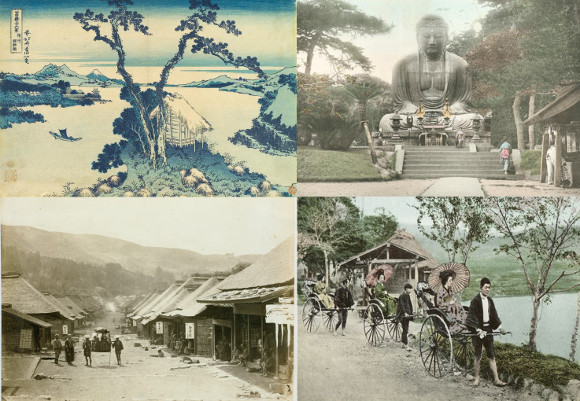
From breastfeeding mothers to merchant towns and an evening party with kimono-clad girls in Kyoto, these newly released artworks and photos of old Japan are simply captivating.
The New York Public Library released more than 180,000 items from their digital archives on 1 January this year, labelling them free for use in the public domain. Always keen to take a stroll back in time to an era when people wore kimono in their day-to-to-day lives, we dove into the new collection and came back up with some fascinating tales of rickshaws, sword parts, exquisite artworks and well-known landmarks that have stood the test of time.
▼ The full collection of the famous Tōkaido Gojūsan Tsugi no Uchi (The Fifty-three Stations of the Tokaido) woodblock print series by HiroshigeAndō (1797-1858) is one of the first things you’ll come across in the extensive digital library.
There are a number of ukiyo-e woodblock prints by one of Japan’s most highly regarded artists, Utamaro Kitagawa (1753?-1806). Known for his bijin-ga (portraits of beautiful women), Utamaro’s work became popular in Europe in the mid-1900s, influencing many impressionist artists.
▼ Chichi (About to Breastfeed). “Chi chi” means “milk” or “breast” in Japanese.
▼ Kami yui (Hairdresser)
▼ Images from Baika jô (The Plum Blossom Album) (1808) feature some beautiful art by Baikan Okada (1773-1849).
▼ One of the masters of ukiyo-e was Katsushika Hokusai (1760-1849). This work, depicting Lake Suwa, Province of Shinano, is from his famous series, Thirty-Six Views of Mt. Fuji.
Alongside the beautiful artworks, there are photographic records of important objects related to Japanese culture and daily life.
▼ These printed swatches show the types of patterns used on textiles and clothing over a hundred years ago.
▼ Decorative sword guards, which were located between the blade and the hilt, came in a large number of intricate designs.
▼ And there are even some images of kimono dating back to 1911.
▼ An Illustration of Costumes 2 (1908) shows a variety of hakama (Japanese pleated pants for men) and haori (Japanese kimono coats).
▼ This colourful shot (c.1898-1931) takes its title, “Three Little Maids From School Are We”, from the song of the same name which first appeared in the musical The Mikado, in London in 1885.
▼ Town of Odowara [sic] in the 1870s. Located in the southwest of Kanagawa Prefecture, this was a prosperous post town on the Tokaido Highway, which linked the imperial city of Kyoto with the shogun’s capital of Edo (modern-day Tokyo).
▼ View of Hakoni Village [sic] shows Hakone, in Kanagawa Prefecture, in the 1870s.
A large number of photographs were published by Imperial Government Railways Co. in the 1910s, depicting famous areas and landmarks. It’s amazing to see just how much the world has changed around these well-known spots over the years.
▼ Enoshima, a Popular Island Excursion Resort near Tokyo.
▼ A View of Mt. Fuji, Height 12,370 ft.
▼ Grand Shrine of Ise, of the Highest Sanctity in Japan, Sacred to the Imperial Ancestress; Showing Pure Archaic Style of Japanese Architecture.
▼ The Daibutsu or Gigantic Bronze Statue of Buddha at Kamakura, a Former Feudal Capital.
▼ Entrance to the Kasuga Shrine at Nara and Group of Consecrated Maidens.
▼ The Kinkakuji – ‘Golden Pavilion’ – Kyoto. A Villa of an Early Shôgun.
▼ Enjoying the Cool of a Summer Evening on the Kamogawa in Kyôto.
▼ Dotombori – a Popular Amusement Quarter in Osaka.
A journey into the digital collection from the New York Public Library is a truly eye-opening experience. Beware though; with such a large number of photographs documenting the rich history and culture of Japan, you’re likely to get lost in there for hours!
Source: Japaaan
Images: New York Public Library Digital Collection